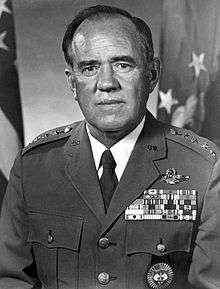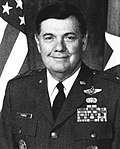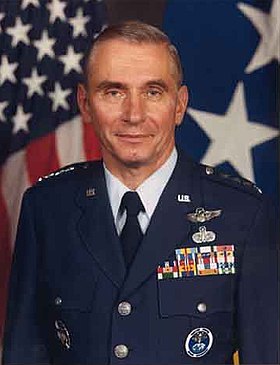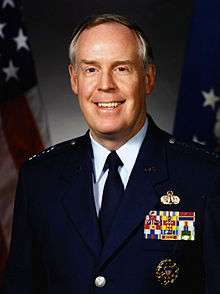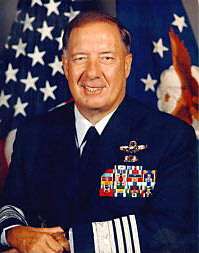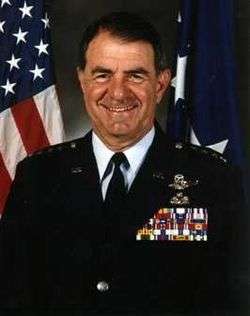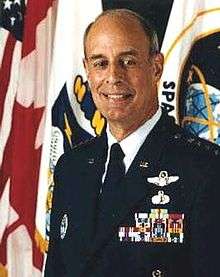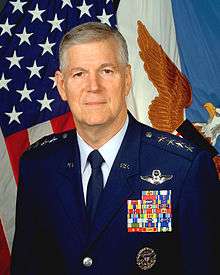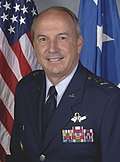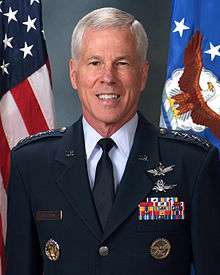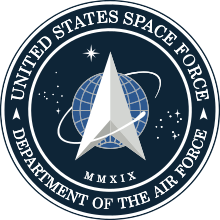Air Force Space Command
Air Force Space Command (AFSPC) was a major command of the United States Air Force from September 1982 to December 2019. On 20 December 2019, concurrent with the signing of the National Defense Authorization Act for 2020, it was re-designated as the United States Space Force and became a new sixth service branch of the United States Armed Forces responsible for space warfare.[4]
| Air Force Space Command | |
|---|---|
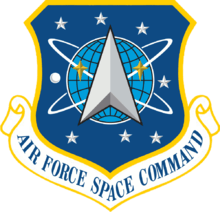 Shield of Air Force Space Command | |
| Active | 1 September 1982 – 20 December 2019 (37 years, 3 months) Detailed
|
| Country | |
| Branch | |
| Type | Major command |
| Role | Space warfare[2] |
| Part of | |
| Headquarters | Peterson Air Force Base, Colorado, U.S. |
| Motto(s) | "Guardians of the High Frontier"[3] |
| Decorations | Air Force Organization Excellence Award[1] |
| Website | www |
AFSPC had its headquarters at Peterson Air Force Base and supported U.S. military operations worldwide through the use of many different types of space operations. More than 38,000 people performed AFSPC missions at 88 locations worldwide; including military personnel of the USAF, Air Force Reserve and Air National Guard; Department of the Air Force civilians; and civilian contractors.
History
In 1982, Space Command was formed to centralize missile warning operations (formerly a Strategic Air Command responsibility) and space launch operations (formerly an Air Force Systems Command responsibility). In 1985, Space Command was renamed Air Force Space Command (AFSPC).
In 1991, the lessons learned during Operation Desert Storm provided emphasis for AFSPC's new focus on support to other branches of the military. AFSPC was the subject of a 60 Minutes News segment on CBS in April 2015. When speaking with reporter David Martin, commanding General John E. Hyten was able to state that the program was doing its part in keeping the global world of GPS satellites and other important global satellite usage peaceful. Possible issues included the development of anti-satellite technology, and the new Boeing X-37 spaceplane was also discussed.[5]
In 2016 Air Force Space Command began its Space Mission Force concept of operations to respond quickly to attacks in space.[6] Each Space Wing's space operators underwent special training before serving a four to six month mission rotation.[7]
On 20 December 2019, Air Force Space Command was redesignated as the U.S. Space Force and elevated to become a military service.[8]
Mission
According to AFSPC, its mission was to "Provide resilient and affordable space capabilities for the Joint Force and the Nation."[9]
AFSPC's primary mission areas were:
- National Security Space Launch: The launching of satellites and other high-value payloads into space using a variety of expendable launch vehicles and operating those satellites once in space
- Space control: ensuring the friendly use of space through the conduct of counterspace operations encompassing surveillance, negation, protection and space intelligence analysis[10]
- Force enhancement: providing satellite-based weather, communications, intelligence, missile warning, and navigation
Space capabilities
Operations at Vandenberg Air Force Base and Cape Canaveral Air Force Station provided services, facilities and range safety control for the conduct of space launches. AFSPC was responsible for the command and control of all US DoD satellites, providing global coverage, secure communications, weather and navigational data, and threat warning. Ground-based radar and Defense Support Program satellites monitored ballistic missile launches around the world to guard against a surprise missile attack on North America. Space surveillance radars provided vital information on the location of satellites and space debris for the nation and the world.
Space Situational Awareness was the most important protective measure that could be applied to satellites, which are inherently vulnerable due to the physics of spaceflight.[11] As of 2013, AFSPC was also considering the replacement of a few large multimission satellites with larger numbers of smaller single purpose platforms.[12] This may be used to defend against ASATs by increasing the number of targets that would need to be attacked to neutralize space-based capabilities.[13]
Resources
Satellites
Space situational awareness
- Air Force Satellite Control Network
- Maui Optical Tracking Identification Facility
- Ground-Based Electro-Optical Deep Space Surveillance System
- Passive Space Surveillance System
- Rapid Attack Identification Detection Reporting System
- AN/FPS-85 Space Track Radar
Ballistic missile warning radars
- AN/FPS-115 PAVE PAWS
- AN/FPS-108 Cobra Dane
- AN/FPQ-16 Perimeter Acquisition Radar Characterization System (PARCS)
- Sea-based X-band Radar
- Ballistic Missile Early Warning System (BMEWS)
Organization
Fourteenth Air Force
The Fourteenth Air Force (14 AF) was an active Numbered Air Force that was located at Vandenberg AFB, California. It was responsible for launching payloads to space from facilities in California and Florida and managed the generation and employment of space forces to support U.S. Strategic Command and North American Aerospace Defense Command (NORAD) operational plans and missions.[14]
Direct Reporting Units
AFSPC was responsible for providing space assets to the U.S. Strategic Command. AFSPC also supported NORAD with ballistic missile warning information, operates the Space Warfare Center to develop space capabilities, and was responsible for the US DoD ICBM follow-on operational test and evaluation program.
The Space and Missile Systems Center (SMC) at Los Angeles AFB, California, designs and acquires all Air Force and most Department of Defense space systems. It oversees launches, completes on-orbit checkouts, then turns systems over to user agencies. It supports the program executive officer for Space on the NAVSTAR Global Positioning, Defense Satellite Communications and MILSTAR systems. SMC also supports the Defense Meteorological Satellite Program and the Follow-on Early Warning System. In addition, it supports development and acquisition of land-based intercontinental ballistic missiles for the Air Force Program Executive Office for Strategic Systems.
Locations
The AFSPC headquarters was a major unit located at Peterson AFB, Colorado. There were six AFSPC host bases:
- Buckley AFB, Colorado
- 460th Space Wing
- 233rd Space Group (Colorado Air National Guard)
- Los Angeles AFB, California
- Space and Missile Systems Center
- Global Positioning Systems Directorate
- Space Superiority Systems Directorate
- Launch Systems Directorate
- Infrared Space Systems Directorate
- Defense Weather Systems Directorate
- Military Satellite Communications Systems Directorate
- Space Logistics Directorate
- Missile Defense Systems Directorate
- Space Development and Test Directorate (Kirtland AFB, New Mexico)
- Spacelift Range and Network Systems Division
- 61st Air Base Group
- 61st Civil Engineering and Logistics Squadron
- 61st Medical Squadron
- 61st Mission Support Squadron
- Space and Missile Systems Center
- Patrick AFB and Cape Canaveral AFS, Florida
- 45th Space Wing
- 114th Space Control Squadron (Florida Air National Guard)
- 45th Space Wing
- Peterson AFB, Colorado
- 21st Space Wing
- 821st Air Base Group (GSU at Thule Air Base, Greenland)
- 20th Space Control Squadron (GSU at Eglin AFB Site C-6, Florida
- 310th Space Wing (AFRC)
- 21st Space Wing
- Schriever AFB, Colorado
- Vandenberg AFB, California
- 14th Air Force
- 30th Space Wing
AFSPC also operated several Air Force Stations for launch support and early warning missions:
- Cape Cod Air Force Station, Massachusetts
- Cavalier AFS, North Dakota
- Cheyenne Mountain AFS, Colorado
- Clear Air Force Station, Alaska
- 13th Space Warning Squadron
- 213th Space Warning Squadron (Alaska Air National Guard)
- Greeley Air National Guard Station, Colorado
- 137th Space Warning Squadron (Colorado Air National Guard
- New Boston AFS, New Hampshire
- 23d Space Operations Squadron
List of commanders
| No. | Commander | Term | |||
|---|---|---|---|---|---|
| Portrait | Name | Took office | Left office | Duration | |
| 1 | General James V. Hartinger | 1 September 1982[15][16] | 20 July 1984 | 1 year, 323 days | |
| 2 | General Robert T. Herres | 20 July 1984 | 1 October 1986 | 2 years, 73 days | |
| 3 | Major General Maurice C. Padden | 1 October 1986 | 29 October 1987 | 1 year, 28 days | |
| 4 | Lieutenant General Donald J. Kutyna | 29 October 1987 | 29 March 1990 | 2 years, 151 days | |
| 5 | Lieutenant General Thomas S. Moorman Jr. | 29 March 1990 | 23 March 1992 | 1 year, 360 days | |
| 6 | General Donald J. Kutyna | 23 March 1992 | 30 June 1992 | 99 days | |
| 7 | General Chuck Horner | 30 June 1992 | 13 September 1994 | 2 years, 106 days | |
| 8 | General Joseph W. Ashy | 13 September 1994 | 26 August 1996 | 1 year, 348 days | |
| 9 | General Howell M. Estes III | 26 August 1996 | 14 August 1998 | 1 year, 353 days | |
| 10 | General Richard B. Myers | 14 August 1998 | 22 February 2000 | 1 year, 192 days | |
| 11 | General Ralph E. Eberhart | 22 February 2000 | 19 April 2002 | 2 years, 56 days | |
| 12 | General Lance W. Lord | 19 April 2002 | 1 April 2006 | 3 years, 347 days | |
| - | Lieutenant General Frank Klotz Acting | 1 April 2006 | 26 June 2006 | 86 days | |
| 13 | General Kevin P. Chilton | 26 June 2006 | 3 October 2007 | 1 year, 99 days | |
| - | Lieutenant General Michael A. Hamel Acting | 3 October 2007 | 12 October 2007 | 9 days | |
| 14 | General C. Robert Kehler | 12 October 2007 | 5 January 2011 | 3 years, 85 days | |
| 15 | General William L. Shelton | 5 January 2011 | 15 August 2014 | 3 years, 222 days | |
| 16 | General John E. Hyten | 15 August 2014 | 25 October 2016 | 2 years, 71 days | |
| 17 | General John W. Raymond | 25 October 2016 | 20 December 2019 | 3 years, 56 days | |
See also
References
- "Air Force Space Command (USAF)". Air Force Historical Research Agency.
- "Air Force Space Command > About Us". www.afspc.af.mil.
- "Air Force Space Command Heritage". Air Force Space Command. Archived from the original on 22 March 2014. Retrieved 21 March 2014.
- Browne, Ryan (21 December 2019). "With a signature, Trump brings Space Force into being". CNN. CNN. Retrieved 21 December 2019.
When President Donald Trump signed the National Defense Authorization Act into law Friday, he also created the newest military service and the first new service since the US Air Force came into being in 1947. With his signature, the US Air Force Space Command was designated the United States Space Force, a step that White House officials are touting as a historic step. "The law states that Air Force Space Command will be re-designated the United States Space Force, that will happen immediately," Gen. John Raymond, the commander of US Space Command and Air Force Space Command, told reporters at the Pentagon Friday.
- "The Battle Above, part two". CBS News. CBS Interactive Inc. Retrieved 7 May 2015.
- "Details of Space Mission Force now available from AF Space Command". www.afspc.af.mil. AFSPC. 15 July 2016. Retrieved 1 October 2016.
- Gruss, Mike (20 July 2016). "U.S. Air Force expands space warfare training". spacenews.com. spacenews.com. Retrieved 17 October 2016.
- "Fact Sheet". www.spaceforce.mil.
- "Air Force Space Command". Air Force Space Command.
- Brown, Peter J. (9 July 2009). "Mixed signals over Chinese missiles". Asia Times Online. Retrieved 3 April 2013.
- "Future of USAF Space Command". Defense News. 30 September 2012. Archived from the original on 2 October 2012. Retrieved 3 April 2013.
- "Disaggregation in Space: A Strategy for National Security Space in an Era of Fiscal Austerity?". George Marshall Institute. Retrieved 3 April 2013.
- "Space: Disruptive Challenges" (PDF). Air University. Retrieved 3 April 2013.
- "14th Air Force (Air Forces Strategic)". Vandenberg Air Force Base website. United States Air Force. Archived from the original on 21 April 2013. Retrieved 3 April 2013.
- http://www.space-library.com/0908AFM_SpaceAlmanac.pdf
- https://www.afhra.af.mil/About-Us/Fact-Sheets/Display/Article/433549/air-force-space-command-usaf/
![]()
External links
- "Air Force Space Command Fact Sheet". Air Force Space Command. August 2015. Archived from the original on 3 March 2016.
- "Air Force Space Command Fact Sheet". Air Force. April 2003. Archived from the original on 24 June 2003.
